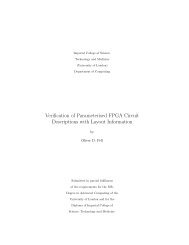A Survey of Monte Carlo Tree Search Methods - Department of ...
A Survey of Monte Carlo Tree Search Methods - Department of ...
A Survey of Monte Carlo Tree Search Methods - Department of ...
You also want an ePaper? Increase the reach of your titles
YUMPU automatically turns print PDFs into web optimized ePapers that Google loves.
IEEE TRANSACTIONS ON COMPUTATIONAL INTELLIGENCE AND AI IN GAMES, VOL. 4, NO. 1, MARCH 2012 6<br />
Selection Expansion Simulation Backpropagation<br />
<strong>Tree</strong><br />
Policy<br />
Fig. 2. One iteration <strong>of</strong> the general MCTS approach.<br />
Algorithm 1 General MCTS approach.<br />
function MCTSSEARCH(s0)<br />
create root node v0 with state s0<br />
while within computational budget do<br />
vl ← TREEPOLICY(v0)<br />
∆ ← DEFAULTPOLICY(s(vl))<br />
BACKUP(vl, ∆)<br />
return a(BESTCHILD(v0))<br />
the tree until the most urgent expandable node is<br />
reached. A node is expandable if it represents a nonterminal<br />
state and has unvisited (i.e. unexpanded)<br />
children.<br />
2) Expansion: One (or more) child nodes are added to<br />
expand the tree, according to the available actions.<br />
3) Simulation: A simulation is run from the new node(s)<br />
according to the default policy to produce an outcome.<br />
4) Backpropagation: The simulation result is “backed<br />
up” (i.e. backpropagated) through the selected<br />
nodes to update their statistics.<br />
These may be grouped into two distinct policies:<br />
1) <strong>Tree</strong> Policy: Select or create a leaf node from the<br />
nodes already contained within the search tree (selection<br />
and expansion).<br />
2) Default Policy: Play out the domain from a given<br />
non-terminal state to produce a value estimate (simulation).<br />
The backpropagation step does not use a policy itself,<br />
but updates node statistics that inform future tree policy<br />
decisions.<br />
These steps are summarised in pseudocode in Algo-<br />
Default<br />
Policy<br />
rithm 1. 6 Here v0 is the root node corresponding to state<br />
s0, vl is the last node reached during the tree policy<br />
stage and corresponds to state sl, and ∆ is the reward<br />
for the terminal state reached by running the default<br />
policy from state sl. The result <strong>of</strong> the overall search<br />
a(BESTCHILD(v0)) is the action a that leads to the best<br />
child <strong>of</strong> the root node v0, where the exact definition <strong>of</strong><br />
“best” is defined by the implementation.<br />
Note that alternative interpretations <strong>of</strong> the term “simulation”<br />
exist in the literature. Some authors take it<br />
to mean the complete sequence <strong>of</strong> actions chosen per<br />
iteration during both the tree and default policies (see for<br />
example [93], [204], [94]) while most take it to mean the<br />
sequence <strong>of</strong> actions chosen using the default policy only.<br />
In this paper we shall understand the terms playout and<br />
simulation to mean “playing out the task to completion<br />
according to the default policy”, i.e. the sequence <strong>of</strong><br />
actions chosen after the tree policy steps <strong>of</strong> selection and<br />
expansion have been completed.<br />
Figure 2 shows one iteration <strong>of</strong> the basic MCTS algorithm.<br />
Starting at the root node 7 t0, child nodes are<br />
recursively selected according to some utility function<br />
until a node tn is reached that either describes a terminal<br />
state or is not fully expanded (note that this is not<br />
necessarily a leaf node <strong>of</strong> the tree). An unvisited action<br />
a from this state s is selected and a new leaf node tl is<br />
added to the tree, which describes the state s ′ reached<br />
from applying action a to state s. This completes the tree<br />
policy component for this iteration.<br />
A simulation is then run from the newly expanded<br />
leaf node tl to produce a reward value ∆, which is then<br />
6. The simulation and expansion steps are <strong>of</strong>ten described and/or<br />
implemented in the reverse order in practice [52], [67].<br />
7. Each node contains statistics describing at least a reward value<br />
and number <strong>of</strong> visits.















